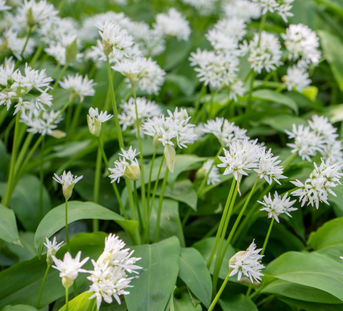Spring is a time of growth and renewal in Scotland, and it is also a time for wild herbs to start flourishing. Wild herbs have been used for centuries for their medicinal properties, and they continue to be popular today. In the 19th century before Edinburgh was quite as metropolitan as it is now, our founder Duncan Napier would venture out in the early mornings to make herb collections on what was then the countryside of the outskirts of Edinburgh. Duncan wasn’t the only person out collecting herbs and he recounts a time he had plans to collect comfrey from a spot by a river only to find someone else already harvesting it – a disagreement ensued as to who had been collecting the comfrey first! Whilst comfrey is good for skincare, these days its not used much in herbalist practise, below is a list of spring herbs that you can look out for on your walks.
Wild Garlic
Wild garlic, also known as Ramsons, is a wild herb that grows in damp woodland areas throughout Scotland the season goes from February through to April depending on the weather. The plant has a distinctive garlic smell and taste which sometimes can envelope a whole area, and its leaves can be used in cooking. When collecting wild garlic make sure you only pick the garlic leaves and don’t inadvertently pick up other shoots which can sometimes be amongst the garlic - lords and ladies (Arum maculatum) being one to avoid. The leaves are much preferable to the bulbs of the wild garlic, so don’t bother trying to dig them up. To make an easy Wild garlic butter, wash the ramsons, dry, whizz the leaves with a blender with some butter and season well with salt and pepper. If you need an extra punch of garlic add a regular bulb before whizzing up, you should find the butter when used in garlic bread or added to a grilled vegetable gives a lighter herbaceous garlicky lift – quite delicious. Wild garlic has been used traditionally to treat digestive problems and high blood pressure by herbalists.
Elderflower (Sambucus nigra)
Elderflowers are the white flowers of the elder tree and can be found growing in hedgerows and along riverbanks throughout Scotland. The flowers have a sweet fragrance and are often used to make cordials and teas – the flower heads are added to impart their perfumed flavour to whatever is being made. When located often you will find many of the smaller shrub like trees clustered together so its possible to make good collections with little effort. Elderflower has been used traditionally to treat colds, flu, and other respiratory infections.
Dandelion (Taraxacum officinale)
Dandelions are a common weed that can be found growing in fields and meadows throughout Scotland. The plant has yellow flowers and green leaves, and its roots and leaves can be used in cooking – they make a nice addition to spring salad. Dandelion has been traditionally used to detoxify the liver and to treat digestive problems. Dried dandelion roots can be used to make a delicious soothing tea. In the early 20th century Napiers supplied its dandelion tea all over the world. In our archives we have letters from shops and tea houses in the USA imploring “Dr Napier” to send bushels of his dandelion tea as quickly as possible as they could sell “packets and packets of it each day”.
Nettle (Urtica dioica)
Nettles are a herbaceous perennial that can be found growing in hedgerows, fields, and woodland areas throughout Scotland. It will also be one of the first plants to make itself known as spring kicks off – you can see it towering above the rest of the hedgerow very quickly. Nettles are difficult to farm, although they seem ubiquitous they are actually quite fussy and have proved tricky to cultivate at scale. The plant has stinging hairs on its leaves, and its leaves and roots can be used in cooking, when picking wear gloves or grasp firmly to flatten the stinging hairs before you grab it. Nettles have been traditionally used to treat allergies, arthritis, and skin conditions. One of the most popular herbs at Napiers today – you can read more about it from our research herbalist expert Monica Wilde The Surprising Superpowers of Nettle Seed | Napiers.
Cowslip (Primula veris)
Cowslip is a wildflower that can be found growing in meadows and grasslands throughout Scotland. The plant has yellow flowers and green leaves, and its flowers and leaves can be used in cooking. Cowslip has been traditionally used to treat headaches, coughs, and colds. Quite easy to confuse with primrose so be sure you’ve properly identified it.
Wild Thyme (Thymus serpyllum)
Wild thyme is a herb that can be found growing on heaths, grasslands, and rocky areas throughout Scotland. The plant has purple flowers and green leaves, and its leaves and flowers can be used in cooking. Wild thyme has been traditionally used to treat respiratory infections, digestive problems, and headaches. Make your own thyme syrup at home.
Violets (Viola odorata)
Violets are a sweet smelling wildflower that can be found growing in woodland areas throughout Scotland. The plant has delicate purple flowers and green leaves, and its flowers and leaves can be used in cooking. Violets have been traditionally used to treat melancholy, coughs, colds, and sore throats. These little flowers were a favourite of Duncan Napiers as he mentions them in some of his writing and poetry.

